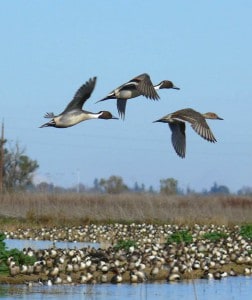Share this article
JWM study: How conservation efforts help dabbling ducks
Habitat conservation programs in California’s Central Valley might be helping the area’s wintering ducks maintain better body conditions than they had in the past.
As part of a recent study published in the Journal of Wildlife Management, researchers compared body mass of dabbling ducks harvested by hunters in the Central Valley from 1979-1993 with those from 2006-2008. Their goal was to determine if the Central Valley Joint Venture conservation program that came about after the 1986 North American Waterfowl Management Plan had any influence on the ducks’ body condition. The management plan was created as a joint effort between the United States, Canada and Mexico to restore waterfowl habitat that had been lost over time to a level that is adequate to maintain healthy populations of waterfowl throughout North America.

©Robert McLandress
As part of the Central Valley Joint Venture, managers restored thousands of acres of wetlands and promoted better agricultural practices such as flooding rather than burning or plowing rice stubble post-harvest. However, biologists hadn’t yet studied the impacts of these habitat improvements on waterfowl and other wetland species in the area, according to Joseph Fleskes, a wildlife research biologist at the Dixon, California Field Station of the USGS Western Ecological Research Center and lead author of the study.
After comparing the data, Fleskes and his colleagues found dabbling duck body mass was greater in 2006-2008 than in 1979-1993. “We can’t say it was a definite cause and effect, but we found improved habitat led to improved winter body condition, especially for duck species that are primarily seed eaters during winter such as pintails (Anas acuta), mallards (Anas platyrhynchos) and American wigeon (Anas americana),” he said. “Their body mass increased quite a bit.”
Fleskes and his colleagues continued to study dabbling ducks in the Central Valley during the last two winters to determine how California’s recent drought has impacted their body condition. Although there was near-normal precipitation in parts of the Central Valley in this most recent winter, lower than normal precipitation in prior years means less water in reservoirs, resulting in less than normal amounts of habitat, he said. According to Fleskes, preliminary results indicate slightly lower body mass in the last two drought winters than during 2006-2008, but it was still better than the condition of ducks, even in fairly wet years, during the 1970s and 1980s. “We haven’t drought-proofed the area, but we’ve made some pretty good improvements in the right direction to maintain habitat that’s critical for waterfowl and other wetland-dependent wildlife,” he said.
Header Image: Northern pintails on a managed wetland in the Central Valley of California. ©Robert McLandress








